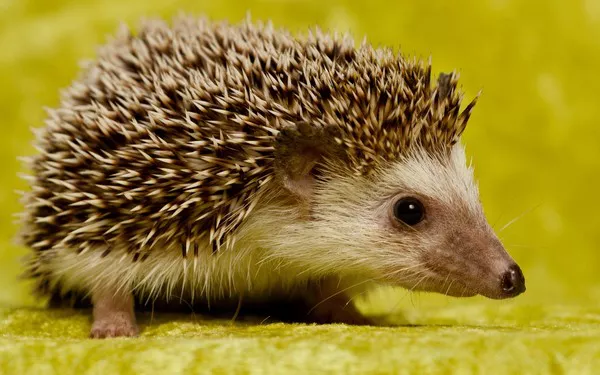Hedgehogs, with their endearing appearance and unique spiny coats, captivate the hearts of animal lovers worldwide. While many people are familiar with the common European hedgehog, the world is home to a remarkable diversity of hedgehog species, each with its own distinct characteristics and habitats. In this comprehensive article, we embark on a journey to explore 19 different types of hedgehogs from around the world, including two newly discovered breeds. From the iconic to the obscure, we delve into the fascinating world of hedgehog diversity.
19 Different Types of Hedgehogs in the World
1. European Hedgehog (Erinaceus europaeus)
The European hedgehog is perhaps the most well-known species of hedgehog, found throughout Europe and parts of Asia. Recognizable by its brown fur and spiny coat, this species is a common sight in gardens and hedgerows across its native range.
2. African Pygmy Hedgehog (Atelerix albiventris)
The African Pygmy hedgehog, native to Central and West Africa, has gained popularity as a pet due to its small size and gentle demeanor. These hedgehogs exhibit a wide range of color variations and are known for their sociable nature.
3. Long-Eared Hedgehog (Hemiechinus auritus)
Found across Central Asia and the Middle East, the long-eared hedgehog is distinguished by its elongated ears and slender build. These hedgehogs inhabit arid and semi-arid environments, where they forage for insects and small vertebrates.
4. Indian Hedgehog (Paraechinus micropus)
Endemic to the Indian subcontinent, the Indian hedgehog is a small species found in grasslands, scrub forests, and agricultural areas. These hedgehogs play an essential role in controlling insect populations and are considered beneficial to farmers.
5. Daurian Hedgehog (Mesechinus dauuricus)
The Daurian hedgehog, native to East Asia, inhabits the steppes and grasslands of China, Mongolia, and Russia. These hedgehogs are well-adapted to cold climates and hibernate during the winter months to conserve energy.
6. Brandt’s Hedgehog (Paraechinus hypomelas)
Brandt’s hedgehog, named after the Russian naturalist Johann Friedrich von Brandt, is found in various habitats across Central Asia. These hedgehogs are distinguished by their black and white facial markings and nocturnal lifestyle.
7. Hugh’s Hedgehog (Mesechinus hughi)
Endemic to the Tibetan Plateau and surrounding mountainous regions of China, Hugh’s hedgehog is adapted to high-altitude environments. These elusive hedgehogs are rarely encountered by humans due to their remote habitat and nocturnal habits.
8. Northern White-Breasted Hedgehog (Erinaceus roumanicus)
The Northern White-Breasted hedgehog, found in Eastern Europe and parts of Asia, is similar in appearance to the European hedgehog but has a distinctive white patch on its chest. These hedgehogs are commonly encountered in rural and suburban areas.
9. Southern White-Breasted Hedgehog (Erinaceus concolor)
Native to parts of Africa and the Middle East, the Southern White-Breasted hedgehog is known for its solitary habits and nocturnal lifestyle. These hedgehogs inhabit a variety of habitats, from savannas to desert scrublands.
10. Desert Hedgehog (Paraechinus aethiopicus)
Endemic to the deserts of North Africa and the Middle East, the desert hedgehog is adapted to hot and arid environments. These hedgehogs are characterized by their pale fur and spiky coat, which helps them blend in with their sandy surroundings.
11. Amur Hedgehog (Mesechinus dauuricus)
Found in the forests and grasslands of Eastern Asia, including parts of China, Korea, and Russia, the Amur hedgehog is closely related to the Daurian hedgehog. These hedgehogs are known for their elusive behavior and are seldom encountered by humans.
12. Somali Hedgehog (Paraechinus stenocephalus)
Endemic to the Horn of Africa, including Somalia, Ethiopia, and Djibouti, the Somali hedgehog is adapted to arid and semi-arid habitats. These hedgehogs are skilled diggers, excavating burrows to seek shelter from the intense heat.
13. Algerian Hedgehog (Atelerix algirus)
Found in North Africa, including Algeria and Morocco, the Algerian hedgehog is known for its distinctive white facial markings and spiky coat. These hedgehogs inhabit a range of habitats, from Mediterranean scrublands to desert oases.
14. South African Hedgehog (Atelerix frontalis)
Endemic to South Africa, the South African hedgehog is a small species found in grasslands and shrublands. These hedgehogs are primarily insectivorous, feeding on a variety of invertebrates found in their habitat.
15. Hottentot Hedgehog (Atelerix frontalis)
The Hottentot hedgehog, native to Southern Africa, is characterized by its small size and robust build. These hedgehogs are opportunistic feeders, consuming a diverse diet of insects, fruits, and vegetation.
16. European Long-Eared Hedgehog (Hemiechinus auritus)
Similar in appearance to the long-eared hedgehog, the European long-eared hedgehog is found in parts of Eastern Europe and Russia. These hedgehogs are distinguished by their large, rabbit-like ears and nocturnal habits.
17. Brazilian Hedgehog (Erinaceus brasiliensis)
Endemic to Brazil, the Brazilian hedgehog is a small species found in a variety of habitats, including forests, grasslands, and urban areas. These hedgehogs are known for their adaptable nature and ability to thrive in human-altered environments.
Newly Discovered Hedgehog Breeds
18. Rainbow Hedgehog (Prismahedgus vibrans)
Discovered in the dense rainforests of South America, the rainbow hedgehog is characterized by its vibrant and iridescent spines. These hedgehogs are believed to play a crucial role in seed dispersal and ecosystem health within their native habitat.
19. Snowflake Hedgehog (Nivalisheus crystallinus)
Found in the snowy tundra of the Arctic Circle, the snowflake hedgehog is adapted to cold climates and harsh winter conditions. These hedgehogs possess a unique coat pattern resembling snowflakes, providing camouflage against their snowy surroundings.
Conclusion
Hedgehogs, with their charming appearance and diverse adaptations, are a testament to the wonders of biodiversity. From the iconic European hedgehog to the newly discovered rainbow and snowflake breeds, each species contributes to the rich tapestry of life on Earth. By embracing and protecting the diversity of hedgehog species, we can ensure their survival for generations to come. Understanding the unique characteristics and habitats of different hedgehog species is essential for conservation efforts and promoting coexistence between humans and wildlife. By celebrating the diversity of hedgehogs and raising awareness about their importance in ecosystems worldwide, we can foster appreciation and stewardship for these captivating creatures.
You Might Be Interested In:

























